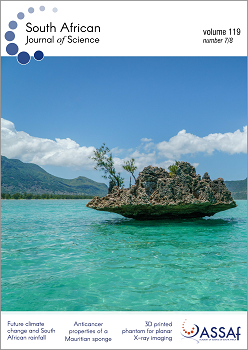Co-infection of urogenital schistosomiasis and malaria and its association with anaemia and malnutrition amongst schoolchildren in Dutse, Nigeria
DOI:
https://doi.org/10.17159/sajs.2023/13846Keywords:
urogenital schistosomiasis, malaria, anaemia, malnutrition, co-infectionAbstract
Schistosomiasis is a neglected tropical disease. Sub-Saharan Africa accounts for 93% of the world’s 207 million schistosomiasis cases. Urogenital schistosomiasis and malaria are both public health problems in Nigeria, where they are endemic. We determined the co-prevalence of urogenital schistosomiasis and malaria in schoolchildren and assessed its implication on anaemia and malnutrition. This cross-sectional study was conducted amongst primary schoolchildren in the Warwade, Saya Saya and Jigawar Daha villages of Nigeria. Urine samples were collected to detect Schistosoma haematobium eggs, and finger prick blood was used for haemoglobin concentration and malaria diagnosis. Nutritional status was assessed using anthropometric measurements and a pre-tested questionnaire. The overall prevalence and density of S. haematobium were 27.7% and 9 eggs/10 mL, respectively, with significant differences between villages and sexes. The prevalence of malaria and infection density was 10.4% and 330 mps/μL, respectively. Co-infection prevalence was 3.3%. Anaemia prevalence was 66%, with significant variation across villages and between sexes. Prevalence of stunting, underweight, and wasting was 41.7%, 46%, and 29.7%, respectively. Mean haemoglobin concentrations in Plasmodium and children co-infected with urogenital schistosomiasis were significantly lower than those who were negative for the infection. No significant association was observed between malnutrition and single or co-infection of urogenital schistosomiasis and malaria. After adjusting for variables associated with anaemia, village of residence remained a significant predictor of anaemia. Water contact activities, such as fishing, swimming, and irrigation, emerged as independent risk factors of S. haematobium infection.
Significance:
Urogenital schistosomiasis and malaria infections are prevalent in communities around Warwade dam in Dutse, Nigeria, and cause anaemia. Continuous monitoring, proper treatment and regular intervention is desirable in the communities.
Published
Issue
Section
License

All articles are published under a Creative Commons Attribution 4.0 International Licence
Copyright is retained by the authors. Readers are welcome to reproduce, share and adapt the content without permission provided the source is attributed.
Disclaimer: The publisher and editors accept no responsibility for statements made by the authors
How to Cite
- Abstract 343
- PDF 812
- EPUB 178
- XML 91












.png)